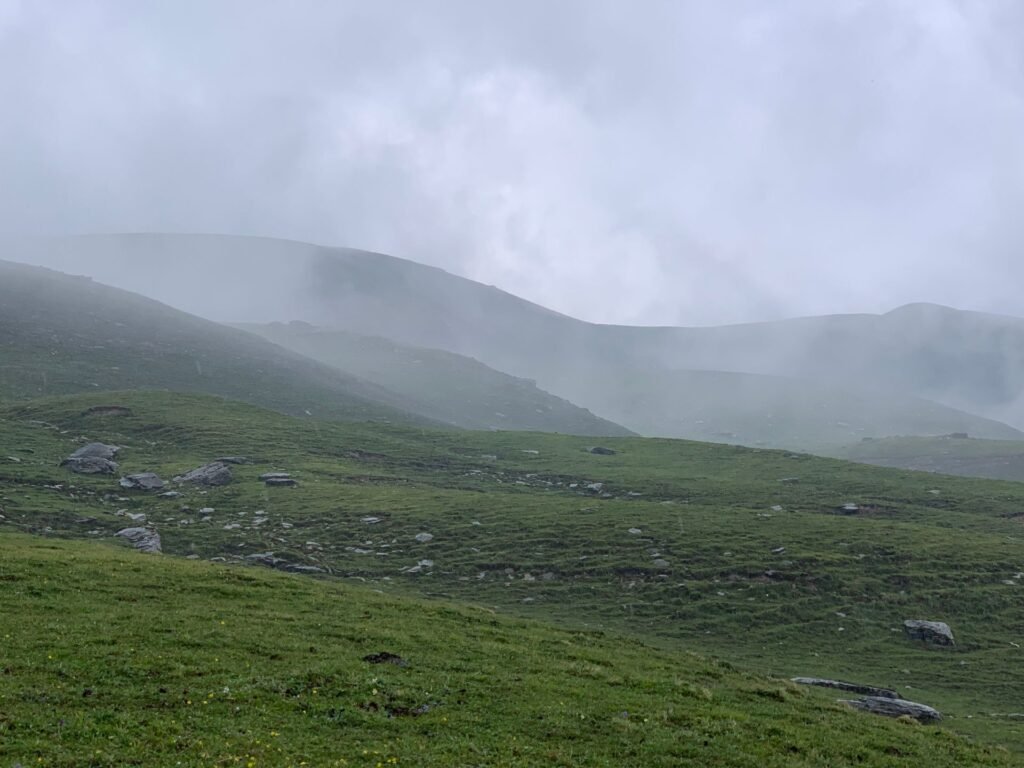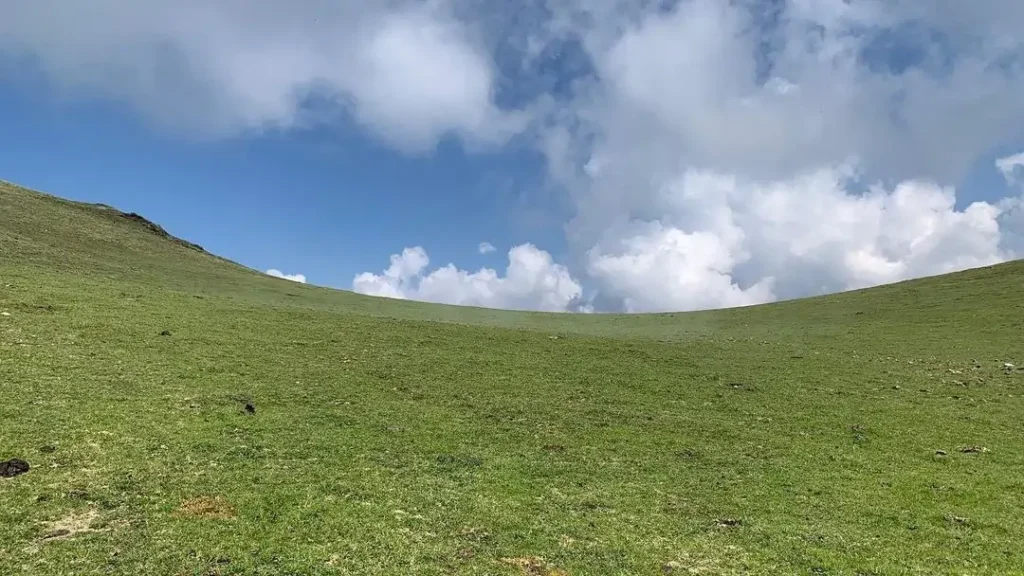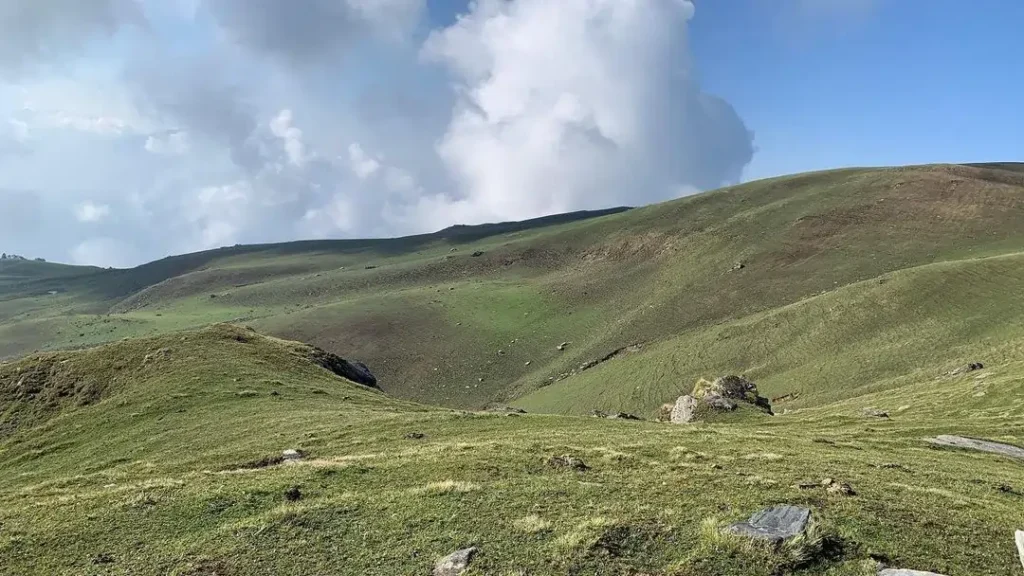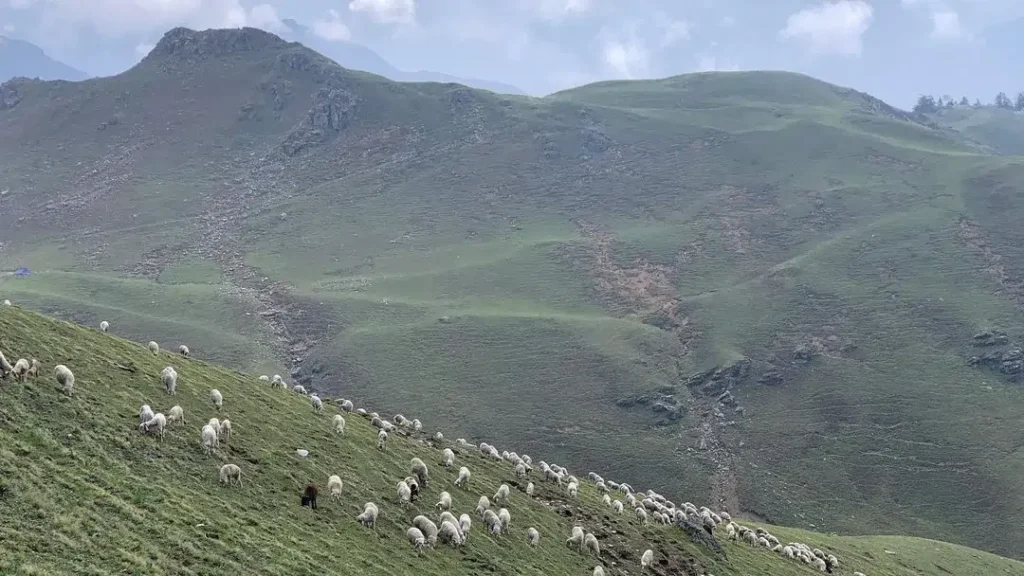“Are you kidding?” It’s the thought you’ll get just as you read the title. Dayara Bugyal Trek in Monsoon? Many will shake their heads in disapproval, I don’t blame them. Regardless, I will advocate it to be one of the best experiences during monsoon.
“To each their own,” is the logic that best suits this hardly-opted-during-monsoon trek. One cannot blame people when they prefer sunny weather, similarly, one cannot blame them if they like uncertainty.
Dayara in the rainy season promises uncertainty. Every step on the stone-clad trail, the pastureland brings you a new uncertainty during monsoon. You’ll have the promise of the greens, the wildlife, the birds, the flowers, and the Indian Himalayan range, but you’ll have the uncertainty of the rains, the mist, and the clouds.
For many, it becomes the reason to fear the trek, for others it’s the reason to embrace it wholeheartedly. My work here is to walk you through the infamous beauty of the Dayara Bugyal Trek in Monsoon. The rest is up to you, you decide whether it’s: Yay! or Neh!

What to expect in Monsoon
For every mountain, there’s a valley; for every descent, there’s an ascent. Similarly, this trek has its own challenges, especially during the monsoon season. If challenges scare you, you’ll be turning back from here, for others, here are the challenges awaiting:
- Thin Air and Oxygen Levels: As you move towards the meadows through the stony trails, the altitude will take a hike. Gradually in your climb uphill, oxygen levels will drop. This will be a cause for concern if you do not acclimatize as you ascend towards your destination. Therefore, take your time, adapt, keep yourself hydrated, and consume a diet rich in carbohydrates.
- Foggy Trails: One minute you’ll see a clear trail that leads you to your destination, another minute your view will be blocked by a thick curtain; a courtesy of the mist. It’s the reason that you are advised to travel with a guide. Believe it or not, they know their way around these silent valleys and towering mountains. If a travel package is “not-your-thing,” you can always hire one of the local guides. For the travel package that best suits you, check out the Dayara Bugyal Trek Package.
- Landslide Alert: Monsoon and landslides in the hills are like the sound of thunder after lightning; one follows the other religiously. When opting for this trek during monsoon, keep in mind that there might arise a situation where the rocks and the soil on the trek decide to prolong your stay. It’s always better to be safe than sorry in these situations, so carry an apt gear to fight through these circumstances, if any at all.
- Unpredictable Rain Showers: Monsoons are unpredictable by nature, you’ll never know when the light rain shower will turn into heavy ones. Is it something to fear? If you are not a fan of rainfall, then yes. If you forgot your poncho, then yes. Otherwise, you are good to go with the rain shelters available at Gui and Chilapada.
- Slippery Slopes: Imagine stepping into a stone, not noticing the algae, moss, or lichens on it. The most likely outcome is that you’ll slip and might twist a leg or two. Avoid this by taking conscious steps, and maintaining a firm hold.
- Spotty Mobile Coverage: A trekker who’s out in the wild will hardly miss the materialism that accompanies their mobile phones. As much as I agree with this fact, it’s also undeniable that mobile phones are your way to stay safe and call for help if and when required. During half the trek, you’ll have little to no issues with mobile coverage. As you climb higher, they’ll get spotty and problematic; therefore, do not travel alone. Following the advisory to be accompanied by a guide should be followed at all times.

Monsoon Itinerary
Day 1: Reach Raithal (Read the guide on how to reach Raithal)
Day 2: Hike Raithal to Gui
Day 3: Gui to Dayara and Back to Gui by evening
Day 4: Gui to Raithal
Day 5: Departure from Raithal Village
Note: The trek is moderate during monsoon. Trekkers should always carry a poncho, extra clothing, waterproof shoes, and plastic bags to keep their gadgets safe. From Raithal to Dayara, there’s a stone pavement, so there’s no mud or slippery route. If it rains heavily, make sure to switch off your phone, avoid open spaces, and stay away from trees.
Dayara Bugyal When The Summer Curtails
This trek is famous for its picturesque views during summer. The vastness of the meadows keeps you spellbound, and you struggle to find words to describe its beauty. Soon, summer ends, and with it the craze to explore Dayara.
Why so? All of a sudden, a beloved grassland with engulfing forest trails, becomes irrelevant, almost discarded. The only reason I can think of is the fear of the unknown. Trekkers are sold a dreamy experience of the Bugyal Trek during summer, autumn, and winter. Monsoon season is left untouched and unexplored, made into a dangerous mystery.
In monsoon will not offer you sunlight or snow. If that’s your idea of adventure and nature, you are better off exploring this trek in summer, autumn, or winter. “Nature’s beauty is eternal.” If you resonate with this thought, you are the ideal candidate for this trek during the monsoon.
Read what our team member Bhuvi Uniyal at Himalayan Dream Treks (HDT) has to say: “I have trekked to various locations in different seasons. My favorite seasons for trekking are autumn and monsoon. Treks like Chandrashila, Kedarnath, and Harunta Bugyal I have done in Monsoon. Autumn offers clear views of the horizon, orange foliage, and a cold breeze. Monsoon, however, is a different story. There’s mist everywhere, limiting visibility. This means trekkers don’t see mountain ranges and valleys due to the mist, but to me, the mist provides a comforting, cradling feeling. Rain represents a god to me. During summers, most forests and sometimes even meadows burn due to forest fires. Then comes the rain, giving them new life. The rain rejuvenates the forests, making everything lively again. Wildlife returns, and there are plenty of grazing grounds for ibex, sheep, and cattle. I did the Dayara Bugyal trek in June 2023 via the Gorsali Route. During my trek, I saw forests full of wild birds and water streams. Initially, I didn’t notice the bird chirping, but later, when I reviewed my recorded videos, I found bird chirping in every video. I also saw a herd of Blue Himalayan Sheep. That night, we stayed with a Gujjar family in a hut, and I learned about the importance of monsoons in meadows and the lives of Gujjars. Apart from that, the meadow was full of wildflowers and clean water streams. The water was so clean that you could drink it right away. There were sheep herds as large as football fields. I will never forget my experience”
Dayara Bugyal, Monsoon, and Local Lore
The 22 km trek is rich in forest trails that give you a superlative sense of exploration. As you climb towards Dayara Top, you’ll come across campsites with smaller sized meadows, chaniya (huts owned by locals), and views that are unique to each campsite. All this isn’t without the company of clouds, mist, trees, birds, animals, streams, and the local lore and festivities. Only the lucky ones can grapple with the opportunity to take part in local festivities. As you read ahead the opportunity will reveal itself, just like the oak trees hiding behind the mist.
- Trek to the Bugyal: Woods, You, and the Mist
All there is to say about the forest trails is that it appears as if, “A lonesome cloud collided with the precipitous hill and doesn’t want to leave the company anymore.” One look at the sweeping valleys and your curiosity about the unknown peaks high. One has a question swirling in their mind as through the green, moss-carpeted surroundings. The question that asks, “What’s beyond this?”
2. Rest on the trails: Streams, Birds, and Animals
For someone climbing to the vast meadows at an altitude of 12,000 ft, rest is inevitable. When resting, it’s nothing short of a feeling equivalent to reaching heaven. Your eyes and ears are greeted by nature’s exquisite beauty in the form of wildflowers, animals, and streams.
The crinkling water streams at more than one place throughout the trek is the courtesy of monsoon showers; a rarity only trekkers in monsoon will experience. One notices the flapping sound of Monals’ and Crows’ wings as the hustle and bustle fades away during the monsoon. Some might say it’s a lone wolf adventure. Apart from the birds, you can spot horses and cattle. On rare occasions, you can spot bears and leopards.



3. Locals Complete The Bugyal
Monsoon, during mid-August, is not only about its alpine pasture lands and wildflowers. It’s also about the local people, their cattle, and their thankfulness to the Bugyal. The monsoon trek binds into the perfect package when one gets to witness the Butter Festival (local name ‘Andhuri Utsav’) at Dayara Bugyal.
The locals gather on this day, thank their local deities, and celebrate the breaking of the sunshine, after the dense monsoon season. It’s also the day when they take back their cattle, after a healthy 3-months of grazing the medicinal herbs that grow in the meadows.
4. Alternative to Valley of Flowers
Due to ongoing infrastructure projects and climate change, the Valley of Flowers has become quite risky. In comparison, Dayara Bugyal is a safer option. The chances of landslides on the Uttarkashi route are lower compared to the Joshimath route. Monsoon treks are done during the monsoon season, and trekkers are aware of the risks involved. Knowing these risks, Dayara Bugyal can be an alternative to the Valley of Flowers within Uttarakhand.
If someone wants to avoid the crowd and experience meadows, forests, and a less risky location, they should consider this trek during monsoon. You will also get to learn about the importance of bugyals in the livelihood of the Pahadi people, as well as their ecological significance.
A Bold Adventure
The sloping flourishing meadows have a lot to offer you in the monsoon. If you decide to camp, you’ll see the clouds playing hide and seek with the majestic mountains. Be it Bandarpoonch on the left to Draupadi Ka Danda on the right, the clouds will paint them.
You’ll witness them diminishing and popping, all controlled by the movement of the clouds. When you look a little below, you’ll see cattle grazing in peace and calm. They can care less about the worries of the world. You won’t care either as you witness shimmering rain slightly moving the wildflowers to dance. The colorful site of Himalayan blue poppies, daisies, primroses, etc. will not allow you to regret the trek in Monsoon.
More to Read: Best Season For Dayara Bugyal

Leave a Comment